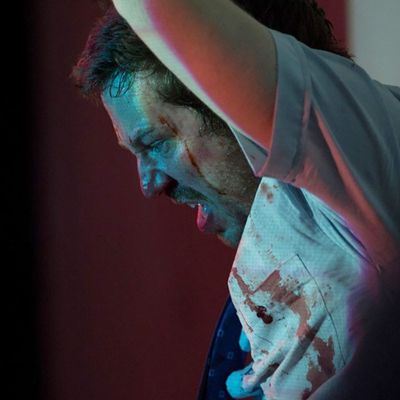
Depending on where you live in America, you could go to the movies this weekend and watch one or more of the following films: John Wick: Chapter 2, Logan, and The Belko Experiment. If you feel like staying home, you could queue up the newly released Catfight, a dramedy that revolves around Sandra Oh and Anne Heche getting into full-on fistfights, or Headshot, an Indonesian action flick in which Iko Uwais fights his way through waves of bad guys until they’re all dead. If you have a massive appetite for high body counts, stunning fight choreography, and general onscreen savagery, Hollywood might finally be meting out enough punishment for you to scream your safe word. Right now, we are in the middle of a golden age for violence onscreen.
Belko Experiment director Greg McLean calls the current moment “a renaissance of gore,” and he’s in a good position to know. The Aussie’s debut feature, Wolf Creek, created one of horror’s great modern villains in Mick Taylor, a sociopath who hunts pigs and tourists in the Australian outback. Creek came out in 2005, when gleeful spree killers were turning mainstream thanks to torture-porn franchises like Saw and Hostel. Along with James Wan, Eli Roth, and a slew of French directors, McLean was on the new frontier of extreme, nihilistic gore cinema.
A lot has changed in the past decade, though, and in 2017, the extreme violence in McLean’s newest feature no longer marks him as a cinematic reprobate; it’s just how movies are now. The Belko Experiment, which follows a building full of American office workers in Colombia forced into a fatal game of last man standing, is in part an anthropological examination of how people react to a “kill or be killed” scenario. But mostly, it’s blood orgy for the hard-core set who want to see people get murdered in absurdly gratuitous ways. Vulture’s Emily Yoshida called it an “ugly and unpleasant film,” but in the context of this weekend at the movies, it’s barely the most extreme offering at the theater. The body count in Belko is actually about half of the total in the new John Wick, and the amount of blood spilled isn’t much different from what you’d see in Logan, this spring’s major superhero movie. Heck, Wolverine’s swan song is even darker than Belko, which sets its violence within a black comedy, instead of in a dystopian desert wasteland where comic-book heroes go to die. If you’re surprised that an X-Men movie can now out-bleak what’s essentially an updated Battle Royale, so is McLean.
“There is that appetite within hard-core horror fans to feel like things have not been pared back by studios,” says the director, who says he fought hard to keep Belko as violent as it is. Based on box-office returns for recent R-rated films built around virtuoso violence — Mad Max: Fury Road, Deadpool, Evil Dead, and now Logan and both Wicks — McLean is right that audience appetites have evolved. As the violence once reserved for scary movies has infiltrated slick action films and super-expensive superhero movies, audiences’ tolerance, and expectation, for brutality has gotten higher. “They want to have a really intense experience,” he says. “I feel like that that has become more mainstream. When you have 20th Century Fox making a Wolverine film that is full-on, hard-core violence, the audience has been cultivated to accept that as being normal. It’s mainstream.” Studio’s aren’t shying away from the distasteful anymore. They’re actually betting big money on it.
The rest of 2017’s big releases reflect more of the same. Once March is over, you can spend the rest of your year working through Atomic Blonde, Free Fire, Kingsman: The Golden Circle, King Arthur, Alien: Covenant, and Wonder Woman. Each of these films are big, shiny, expensive efforts, some of them featuring Oscar-winning performers, that are playing for large box-office grosses and marketed around staggering sequences of violent action. And remember: We started the year with Rogue One, a holiday-season spectacular in which all of the heroes are gunned down or vaporized at the end.
All this is the culmination of a process that started in the 1970s, one that gradually elevated violence to high art and pushed the limits of what viewers define as shocking. If you take the many ultraviolent offerings you’ll see this year as a complete dish it’s easy to pick out the individual ingredients contributed by pioneers like Martin Scorsese, John McTiernan, Quentin Tarantino, Luc Besson, and more.
In making The Belko Experiment, McLean credits one particular ’70s movie with teaching him how to bring elegance to abhorrence. “I remember reading [Francis Ford Coppola] talking about doing The Godfather, and the book was even more violent. It was kind of like a pulp, trashy, very violent exploitation novel that was very popular,” says McLean. “He was talking about how to evolve the film, and he basically said that if you’re gonna do violence, you have your opportunity with each violent moment in cinema to make it unique and interesting, and to be its own little piece of artistry.”
The presence of artistry in brutality is what sets screen violence today apart from previous eras. In the 1970s, when modern cinema violence was born, directors like Tobe Hooper and Wes Craven* led a new school of horror filmmakers who made movies that were more aggressive in their brutality than anything that had come before; the decade’s The Texas Chainsaw Massacre and Last House on the Left were gritty, lo-fi depictions of the evil and the grotesque. On the other side of the prestige spectrum, Coppola delivered The Godfather, which legitimized anti-heroes and unsparing violence with Oscar gold and an historic box-office haul. Later in the decade, Martin Scorsese built on the success of the first two Godfather films with Taxi Driver and Raging Bull, which turned suffering into religious spectacle.
The 1980s, by contrast, made violence into big business in both horror and action. The slasher wave churned out dead teenagers like cheap H&M T-shirts, and unkillable man-beasts Sylvester Stallone and Arnold Schwarzenegger engaged in a figurative (and literal) arms race, as movies like Commando, Predator and First Blood featured the pair as greased-up good guys doing battle against entire armies. At the same time, Paul Verhoeven was making dark, hideous, hilarious films that pioneered the blending of camp and action, and used ultraviolence as a tool for social satire. Verhoeven’s works made violence feel personal and consequential in a way few other filmmakers could. Meanwhile, white martial artists like Jean-Claude Van Damme, Steven Seagal, and Chuck Norris churned out a rapid succession of B-movies that served up assembly lines of ass-kicking. Here the cartoonish levels of punishment served the exact opposite purpose of that in Godfather and Taxi Driver, detaching viewers from the violence by a sheer function of supersaturation.
The 1990s brought style to screen violence, thanks to directors like the Wachowskis, Luc Besson, Quentin Tarantino, Guy Ritchie, and Robert Rodriguez. They also brought charismatic leads that built on the “Yippie ki-yay” legacy of Die Hard’s John McClane, including Antonio Banderas in Desperado, Jean Reno in Léon: The Professional, Nick Moran in Lock, Stock and Two Smoking Barrels, Keanu Reeves in The Matrix, Milla Jovovich in The Fifth Element, and George Clooney in From Dusk Till Dawn — all of them equal parts cool and lethal. Tarantino’s films infused the stark violence of the 1970s with witty repartee, making heroes out of very bad guys.
The aughts saw a parade of fits of high violence that acted as a kind of bridge to our current cinematic landscape. Movies like A History of Violence (2005), The Departed (2006), Eastern Promises (2007), Shoot Em Up (2007), Wanted (2008), and later Kick-Ass (2010) and Drive (2011), blended excessive violence with outlandish central characters and beautiful visuals. But though these types of films became a familiar presence on studio slates, they didn’t become a movement until the first John Wick, which reorganized the limits of violence on film a way we hadn’t seen since the days of The Godfather. Wild spectacles of brutality that used to be annual events on modest budgets now arrive in clusters, often boosted by big marketing campaigns and studio support. With horror also producing consistently excellent material at both independent and studio levels, it’s clear that watching high-concept violence has become a national pastime that not even Disney is turning away from.
It’s as if the best tropes from each generation — the bludgeoning violence of the 1970s, the gaudy mass-cult movies of the 1980s, the charismatic leads of the 1990s, and the bold stylization of the 2000s — have been distilled into a single pot. The best of today’s action films also showcase fight choreography that calls back to the beauty of kung-fu films in the 1950s and ’60s, turning fight scenes into vicious ballets. As the intensity of the action has increased, so too has the elegance, making these new movies bankable and accessible on huge scale. Brutality on film has never been more fun, more beautiful, or more abundant.
It’s hard to imagine where we could possible go from here, when movies like Headshot already fills nearly every available minute with exhaustive showdowns, and Logan has incorporated a preadolescent super-killer. Where do you go after recruiting children? But just as we’ve pushed ourselves to inconceivable limits now, McLean knows the audience’s tolerance can always be pushed a little bit further. “I was talking to someone about [Belko],” he says. “And they said they didn’t think this movie went far enough. And I was like, ‘Wow, you’re hard core.’ I was shocked.” Yippie ki-yay, motherfucker.
*This story previously stated that John Carpenter directed the movie Last House on The Left, and it has been corrected throughout.


